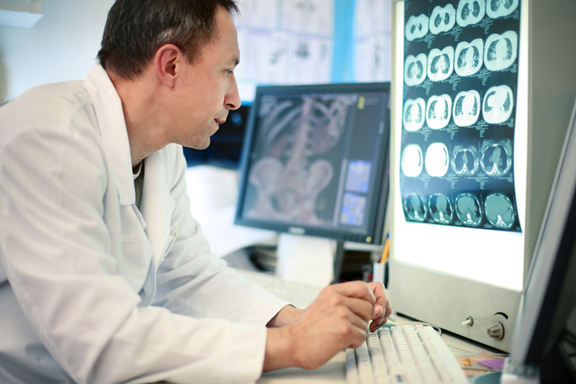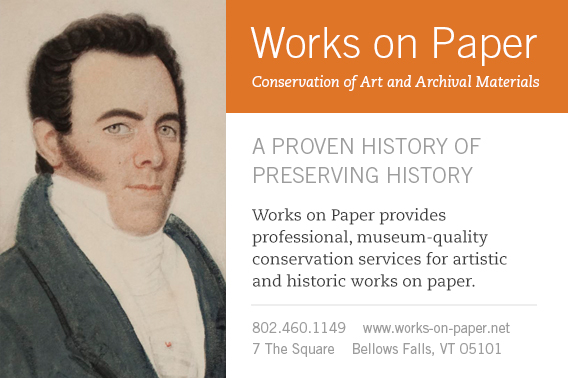
Mindful Observation: Art Museums in the Education of Healthcare Professionals
By Alexa Miller, Founder and Consultant in Arts and Clinical Learning, ArtsPractica with contributions by Michelle Grohe, Director of School and Teacher Programs, Isabella Stewart Gardner Museum, and S. Hollis Mickey, Assistant Educator, Gallery Interpretation, RISD Museum
A common core practice lies at the root of professional thinking in both the arts and in healthcare: close looking. Just as the stewards and advocates of art museum collections inspect objects closely in order to inform their daily decisions, healthcare professionals start with direct observations to understand their patients and to craft the care they provide.
As art museum educators are well aware, the practice of close observation of works of art is deeply interdisciplinary work, with significance far beyond just “visual skills.” Such mindful observation involves critical thinking, collaboration, communication, and reflection all at once—and holds the promise of resulting in states of true presence, openness, connection, and creative “flow.”
Accordingly, the practice of close observation represents a foundational educational building block for many collaborative programs currently developing between museums and healthcare organizations. Innovating on a staggering breadth of issues, these programs ask: Could the work of close observation of works of art have a stake in improving clinical perception and communication skills? Preventing provider burnout? Enhancing humanism and patient-provider relationships? Close observation is significant to a vast, overlapping web of areas within healthcare.
Clinician skills in unbiased seeing, critical thinking, and communication are essential to healthcare quality, especially for addressing the common—and enormously costly—problem of misdiagnosis: errors in medicine are rarely due to faulty knowledge or information; most commonly they occur due to faulty data-gathering, or faulty data-synthesis.[i][ii] Although medical education standards emphasize critical thinking skills, the field lacks consistent models for their teaching and learning. Many art museums already have within their purview real pedagogical expertise with regards to thinking and reflection skills, albeit in an art-viewing context.
There are two case studies, both involving New England medical schools and museums, that are particularly good examples of these theories in action. The first case study involves Boston University Goldman School of Dental Medicine’s two-pronged partnerships with the Isabella Stewart Gardner Museum, Boston, and with Arts Practica, my medical education consultancy. Designed to support both students and faculty with regards to critical thinking skills, these programs dovetail in using the Visual Thinking Strategies protocol for art discussion and its application to dental education.
This program began with enthusiastic curiosity on the part of BUGSDM faculty about the potential for art museum education in dental training. This interest led Dr. Fleisher, somewhat circuitously, to the Gardner Museum—an institution known for deep expertise in the Visual Thinking Strategies method and commitment to strategic educational partnerships. The Gardner was able to begin exploring a partnership with a custom visit designed and led by skilled educators, with the objectives of learning to look, reflecting with peers on skills of future clinical practice, and exposure to Boston cultural resources.
The first year of collaboration revealed that the boundaries between the two cultures of dental and arts education were significant: “Why are we here talking about art?” was a frequent question among students. The institutions responded by increasing efforts to frame the experience. Dr. Fleisher further turned this challenge into an opportunity for dental educators to gain pedagogical experience related to the program’s approach to observation and critical thinking, contracting Arts Practica to lead a workshop for sixty BU dental educators to explore the VTS approach and the current research on its adaptations in healthcare.
Faculty overwhelmingly expressed increased comfort in looking at art and interest in visiting a museum—one unexpected outcome of the workshop that greatly supported the integration of museum education into the curriculum. The second year’s museum visit benefited from increased faculty understanding of the museum experience, and from increased efforts to frame the learning experience on the parts of both the museum and the dental educators.
These efforts were reflected in increased seriousness among the students, deepened engagement with the artworks and VTS process, and more extensive reflection on how these skills used in the art galleries related to their skills used in patient and team interactions as well as diagnoses. Now in its third year, the partnership has developed to the extent where now all BU first-year dental students visit the museum, and further curricular initiatives related to critical thinking continue to experiment with adaptations of VTS.
The second case study is an educational collaboration between Brown Medical School and the Rhode Island School of Design Museum. This work is designed to foster deeper understandings of one’s own habits of mind, and to increase skills and competencies in communication and interdisciplinary collaboration. This multi-tiered program provides sessions, workshops, and courses to emerging doctors across stages of medical education: pre-medical and medical students, as well as residents and attending physicians.
Jay Baruch, MD, Warren Alpert Medical School of Brown University, and S. Hollis Mickey, Assistant Educator, Gallery Interpretation, RISD Museum, employ open-ended inquiry-based pedagogical methods in their work. Physicians and future physicians are guided in close observation, and critical analysis of works of art and facilitated in deep reflexive work, noticing how and why they have made specific observations and interpretations.
Through extended experiences with works of art, the processes of meaning-making are slowed down and closely examined to better understand the individual nature of perception, and how they are influenced by personal experiences, biases, and reactions. As small groups and individually, participants encounter ambiguity, explore how interpretations are constructed and consider how narratives are composed through fragments. Physicians and future physicians are also led in writing and drawing exercises to enrich these processes, promote new, creative approaches that can be applied in clinical settings, and encourage rigorous investigation of how to clearly communicate complex ideas and multimodal experiences.
Creativity and reflexivity are vital to clinical practice. However, these skills are challenging to measure. Brown Medical School and the RISD Museum are working through different models for progressive, systematic evaluation for effective dimensional assessment. Significantly, through the evaluation gathered thus far, participants in these programs have expressed that the sessions have strengthened these skills. Evaluations demonstrate that physicians and future physicians feel that they leave the sessions and courses with increased understanding of personal bias, and new approaches to creative and critical thinking that can be concretely applied to clinical practice. The partnership between Brown Medical School and the RISD Museum continues to grow. With this growth comes the opportunity to investigate the long-term impact and efficacy of this work and to continue develop it to best serve medical education.
It is still early days in an emerging body of work between art museums and healthcare–one that opens a whole new set of challenges and opportunities. While there are many successes, this work is not without conflict and change. As someone frequently in attendance at medical conferences, I have been surprised to encounter medical educators over the years who carry disappointing stories of their eagerness to explore this work at their local museum, only to be turned away by staff who are either overworked, untrained, or simply uninterested.
The reality is that museums and healthcare organizations alike face tough questions when considering new educational initiatives that require investing resources and crossing disciplines. Who benefits from art museum-medical education programs? And, what are those benefits? Do museum-based medical education programs actually align with the missions and broader roles of museums in society? What does the research say? I am excited to explore these questions as part of my work with such thoughtful, experienced colleagues in the medical community and museum field, and hope more people in both professions will join us to envision the role of the art museum in the future of medicine.
Join the author along with her colleagues from Brown University Medical School and Boston University School of Dental Medicine at the NEMA Conference on Wednesday, November 19, at 3:45 pm.
[i] Graber, M, Franklin, N, and Gordon, R. 2005. “Diagnostic Error in Internal Medicine.” Archives of Internal Medicine 165 (13) (July 11): 1493–1499. doi:10.1001/archinte.165.13.1493.
[ii] Groopman, Jerome E. 2007. How Doctors Think. Houghton Mifflin Harcourt.
